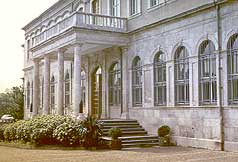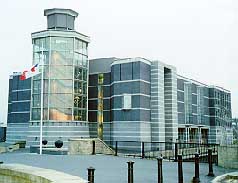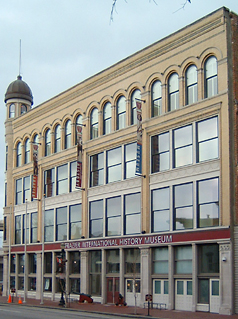Mediaeval Swords in Museums
Please follow this
link to Scharrekoppaeum
where you will find a much more comprehensive and up-to day listing
Introduction
Museums
in Europe
Museums
in North America
Well shielded behind glass for the obvious security reasons and often overstated conservation requirements and viewed at curatorially approved lighting levels, medieval swords in museums might often just as well be plastic reproductions. However, a limited and purely visual museum gallery experience is usually better than none at all, is still generally more satisfactory than a picture on a screen (except perhaps for close-up details), and for most would-be medieval sword enthusiasts may be as good as it gets.
The list below is only preliminary, but better to share now what I can and add to it in time, than to wait until it is all inclusive, but never get around to publishing it. Needless to say, I have omitted much more than I have included. Whenever possible, the museum's name will also be a hyperlink to its official web site, to assist in determining current opening hours and special events. Where I do not have a link to an oficial museum website, I have attempted to include address, phone and routine days closed along with a link to the respective city's website.
Museums in Europe
Denmark
The National Museum of Denmark in Copenhagen has extensive collections ranging from prehistory to the very recent. A large number of Migration Period swords, including many retrieved from peat bogs, are in evidence as are numerous Viking swords and later medieval swords. The edged weapon collection of E. A. Christensen has largely been incorporated into this museum's collection.
Finland
The National Museum of Finland has a large collection of archaeologically recovered swords from the medieval period and before. Only a small representation of this museum's collection is on display. The swords documented in Leppäaho (1961) are largely from this collection. There is also an alternative homepage in Finnish.
Germany
The Württembergisches
Landesmuseum in Stuttgart displays a large number of swords
and other weapons recovered from graves of the Migration Period
in the region. A number of these are illustrated in Behmer (1939) and, more recently and in
color in Die
Alamannen (1997). Only a few later medieval swords are
present, but holdings of preceeding Stone Age, Bronze Age and
Iron Age artifacts are extensive and well displayed. Located
in the Altes Schloß; Schillerplatz 6; 70173 Stuttgart;
Germany, tel. 0711 2 79 0, closed Monday and Tuesday afternoon.
Norway
The Universitetets Oldsaksamling or (University Archeological Museum) in Oslo has outstanding displays of Viking Age swords as well as other artifacts, and what is on display represents only a fraction of their extensive holdings of materials recovered from throughout Norway. Also in Oslo is the Viking Ship Museum (Vikingskipshuset).
Sweden
The Statens Historiska Museum in Stockholm, as may well be expected from a first class national museum, has an extensive collection ranging from prehistory to the present. A large number of Vendel (Migration) Period swords are on display as are Viking swords and later medieval swords. The museum's web site includes a photograph of several Viking swords. Click the link at the bottom of that page to back out into that site.
Switzerland
The Schwab Museum in Biel (Bienne) does not have medieval swords, but does display a substantial and outstanding collection of their precursors in the form of Celtic (500 - 50 BC) iron and steel swords including many recovered from La Tène on nearby Lake Neuchâtel. Bronze Age and Stone Age artifacts including weapons are also on view. Seevorstadt 50; 2500 Biel-Bienne; Switzerland, tel. 032 322 76 03, fax. 032 323 37 68, closed Mondays.
The Schweizerisches Landesmuseum (Musée Suisse) in Zürich has an extensive collection of prehistoric, classical, medieval and renaissance swords, many of which are illustrated in Schneider (1980). When I first visited the museum in the mid-1980's, most of these swords were displayed together in a large room; presently (1998) far fewer are on display, interspersed among other artifacts of the same respective eras.
Turkey
 The
Askeri
Muze or Military Museum in the Harbiye district of Istanbul
is the current repository of the bulk of that remarkable assemblage
of European medieval swords of the 14th and 15th centuries upon
which are datable engraved inscriptions accessioning them into
the arsenal of Alexandria, Egypt and has just over twenty of
its more than sixty remaining examples on display. Following
the defeat of the Mamluks in Alexandria by the Ottomans in the
16th century, these swords came to be housed in the old Byzantine
church of St. Irene (in the outer grounds of the Topkapi palace
complex, also in Istanbul, formerly Constantinople). The collection
is also strong with numerous examples of many of the traditional
weapons and armour of the wide areas which came under Ottoman
influence. The medieval swords, in about as good of condition
as swords of this era can be found, tend to be the earliest weapons
on display and the scope of the displays continues well into
the twentieth century. Plan on spending the entire day and staying
for the colorful performance of the Mehter (Janissary
band) in the final hour before closing. Tel. (0212) 233 27 20
, fax (0212) 240 48 89, hours 9:00 a.m. to 5 p.m., closed Mondays
and Tuesdays. (this information current as of Spring, 1998)
The
Askeri
Muze or Military Museum in the Harbiye district of Istanbul
is the current repository of the bulk of that remarkable assemblage
of European medieval swords of the 14th and 15th centuries upon
which are datable engraved inscriptions accessioning them into
the arsenal of Alexandria, Egypt and has just over twenty of
its more than sixty remaining examples on display. Following
the defeat of the Mamluks in Alexandria by the Ottomans in the
16th century, these swords came to be housed in the old Byzantine
church of St. Irene (in the outer grounds of the Topkapi palace
complex, also in Istanbul, formerly Constantinople). The collection
is also strong with numerous examples of many of the traditional
weapons and armour of the wide areas which came under Ottoman
influence. The medieval swords, in about as good of condition
as swords of this era can be found, tend to be the earliest weapons
on display and the scope of the displays continues well into
the twentieth century. Plan on spending the entire day and staying
for the colorful performance of the Mehter (Janissary
band) in the final hour before closing. Tel. (0212) 233 27 20
, fax (0212) 240 48 89, hours 9:00 a.m. to 5 p.m., closed Mondays
and Tuesdays. (this information current as of Spring, 1998)
United Kingdom
The British Museum is one of the great general historical museums of the world, perhaps the greatest, with extensive collections of worldwide scope. Swords and edged weapons on display are grouped by culture and date and include Celtic, Roman, Migration Period and Viking items. Later examples appear to have been left for the Royal Armouries to interpret.
 The new Royal Armouries in Leeds has been a source
of much controversy among the British arms & armor cognoscente.
First the affrontery of moving the collection away from its traditional
home in London in William the Conquerer's White Tower on the
Thames to a new purpose built structure in a decayed industrial
section of Leeds with a panorama of the British version of "rustbelt,"
then compounded by who was not on the guest list for the
opening in the Spring of 1996 by Her Majesty the Queen. Many
who might enjoy this museum the most have refused to enter the
grounds and I have friends who choose to explain my enthusiasm
for the place only by what they regard as an infinitely American
capacity for enjoyment of vulgarity and gimmickry. Nevertheless,
I cannot help but to thoroughly recommend nothing less than a
full day's visit. After all, the objects are there and are generally
well light and unobstructed. The sound tracks and video screens
are not really that distracting, and some of the programs are
quite good. The costumed interpreter - performers are thoroughly
professional and if their enthusiasm in sharing the subject with
the crowd is not genuine, then they are even better actors than
I think. Visitors have the opportunity to handle the demonstration
props and I recall even a few genuine antiques being passed through
the crowd. The swords start with the Migration period and carry
on into this century. There are only a few Viking swords. I recognized
only two of the museum's three (including the one on loan from
Leeds castle, which is not in Leeds, by the way) Alexandria arsenal swords in the display;
the sword with the finger guard (Oakeshott Records XIX.7) not being out
as of February, 1998 (it may now be now seen at the Royal Armouries
USA at the Frazier). Numerous other
medieval swords are also on display; follow the link for
a listing). I would avoid the introductory film unless your conscience
requires a political correctness calibration prior to entering
the exhibit of weapons; it is easy to back-track into the early
medieval arms exhibit adjoining the screening room. The Royal
Armouries still maintain an exhibit in the White Tower in London;
though I am personally unaware of its extent, I have received
a description
from a fellow reader who has been there. Many of the swords in
the Royal Armouries' collection are illustrated in Dufty.
The new Royal Armouries in Leeds has been a source
of much controversy among the British arms & armor cognoscente.
First the affrontery of moving the collection away from its traditional
home in London in William the Conquerer's White Tower on the
Thames to a new purpose built structure in a decayed industrial
section of Leeds with a panorama of the British version of "rustbelt,"
then compounded by who was not on the guest list for the
opening in the Spring of 1996 by Her Majesty the Queen. Many
who might enjoy this museum the most have refused to enter the
grounds and I have friends who choose to explain my enthusiasm
for the place only by what they regard as an infinitely American
capacity for enjoyment of vulgarity and gimmickry. Nevertheless,
I cannot help but to thoroughly recommend nothing less than a
full day's visit. After all, the objects are there and are generally
well light and unobstructed. The sound tracks and video screens
are not really that distracting, and some of the programs are
quite good. The costumed interpreter - performers are thoroughly
professional and if their enthusiasm in sharing the subject with
the crowd is not genuine, then they are even better actors than
I think. Visitors have the opportunity to handle the demonstration
props and I recall even a few genuine antiques being passed through
the crowd. The swords start with the Migration period and carry
on into this century. There are only a few Viking swords. I recognized
only two of the museum's three (including the one on loan from
Leeds castle, which is not in Leeds, by the way) Alexandria arsenal swords in the display;
the sword with the finger guard (Oakeshott Records XIX.7) not being out
as of February, 1998 (it may now be now seen at the Royal Armouries
USA at the Frazier). Numerous other
medieval swords are also on display; follow the link for
a listing). I would avoid the introductory film unless your conscience
requires a political correctness calibration prior to entering
the exhibit of weapons; it is easy to back-track into the early
medieval arms exhibit adjoining the screening room. The Royal
Armouries still maintain an exhibit in the White Tower in London;
though I am personally unaware of its extent, I have received
a description
from a fellow reader who has been there. Many of the swords in
the Royal Armouries' collection are illustrated in Dufty.
The Wallace Collection in London may appear to be all Eighteenth and Nineteenth Century fine and foppish arts from their web page, but the collection of arms and armor is exceptional. The curator of arms & armor, David Edge, occasionally gives gallery tours, which are excellent and which are listed at the museum's web site. A few early medieval swords of exceptional quality are present. The house and its contents were a bequest to the British nation with the stipulation that the collection would remain intact and without further additions. The European Arms & Armour collection catalogue and later supplement is reasonably comprehensive and remains (if you buy it at the museum) about the best bargain in arms & armor literature that you will find. There is also an extensive collection of Oriental, predominantly Indian, arms & armour which has its own catalogue.
Museums in North America
Canada
The Royal Ontario Museum in Toronto may have the most on display in North America, containing four Viking swords as well as four swords from the Alexandria arsenal inscribed group in addition to several other fine medieval swords.
United States
 The
Frazier International
History Museum in Louisville, KY opened in 2004 and incorporates
the Royal Armouries USA upon its third floor. The Royal Armouries
component of this museum covers European, principally British,
arms and armour from the time of the Norman conquest through
to the close of the 19th century. This exhibit remains well focused
on its topic and is presented in very much the same style as
is seen at Leeds (but without the politically correct distractions
that mar Leeds for some visitors) and incorporate extensive text,
numerous short video films, several life-sized tableau and an
adequate number of representative examples of arms and armour
along the way. The few hundred antique items on display include
some of the Armoury's better items; for example, the Alexandria
arsenal marked medieval sword with the early finger guard, noted
as absent from Leeds above, was on display along with a few additional
medieval swords. The second floor is built around Owsley Brown Frazier's collection and spans
early colonial Americal well into the 20th century. Here the
focus is very much on firearms and their development, but swords
and other ancillary materials are included and the collection's
holdings also include a bow attributed to Geronimo and Teddy
Roosevelt's "big stick." The main floor includes a
large "Arms of Distinction Gallery" which includes
numerous outstanding examples of the gunmaker's craft, with particular
emphasis on applied art and presentation grade examples. A rotating
schedule of live historic interpretations is presented each day
on both American and European-themed topics; I had seen one of
the swordplay demonstrations previously at Leeds; but the Frazier
team's interpretation was of equally high quality, as were the
interpretations original to the Frazier. Having arrived close
to opening, I expected to be done by lunchtime, but I ended up
staying until closing and look forward to visiting again (2009).
The
Frazier International
History Museum in Louisville, KY opened in 2004 and incorporates
the Royal Armouries USA upon its third floor. The Royal Armouries
component of this museum covers European, principally British,
arms and armour from the time of the Norman conquest through
to the close of the 19th century. This exhibit remains well focused
on its topic and is presented in very much the same style as
is seen at Leeds (but without the politically correct distractions
that mar Leeds for some visitors) and incorporate extensive text,
numerous short video films, several life-sized tableau and an
adequate number of representative examples of arms and armour
along the way. The few hundred antique items on display include
some of the Armoury's better items; for example, the Alexandria
arsenal marked medieval sword with the early finger guard, noted
as absent from Leeds above, was on display along with a few additional
medieval swords. The second floor is built around Owsley Brown Frazier's collection and spans
early colonial Americal well into the 20th century. Here the
focus is very much on firearms and their development, but swords
and other ancillary materials are included and the collection's
holdings also include a bow attributed to Geronimo and Teddy
Roosevelt's "big stick." The main floor includes a
large "Arms of Distinction Gallery" which includes
numerous outstanding examples of the gunmaker's craft, with particular
emphasis on applied art and presentation grade examples. A rotating
schedule of live historic interpretations is presented each day
on both American and European-themed topics; I had seen one of
the swordplay demonstrations previously at Leeds; but the Frazier
team's interpretation was of equally high quality, as were the
interpretations original to the Frazier. Having arrived close
to opening, I expected to be done by lunchtime, but I ended up
staying until closing and look forward to visiting again (2009).
The Metropolitan Museum of Art in New York City possesses a very nice Viking sword (pictured in the mostly color guide to the permanent collection; the medieval swords are not in color) and another on loan and several exceptional medieval swords within an extensive collection of international scope (including Islamic and Japanese). There are three Alexandria arsenal swords on display (two on loan from Ron Lauder) and the exceptional wide bladed sword with an inscription inlaid in silver on the rim of the pommel (which is also illustrated in the guide).
The Philadelphia Museum of Art in Philadelphia, Pennsylvania incorporates the Kretzschmar von Kienbusch Collection of Armor and Arms which includes several medieval swords including four from the Alexandria arsenal inscribed group. Much of this collection is illustrated in Mr. Kienbusch's 1963 catalog of his collection.